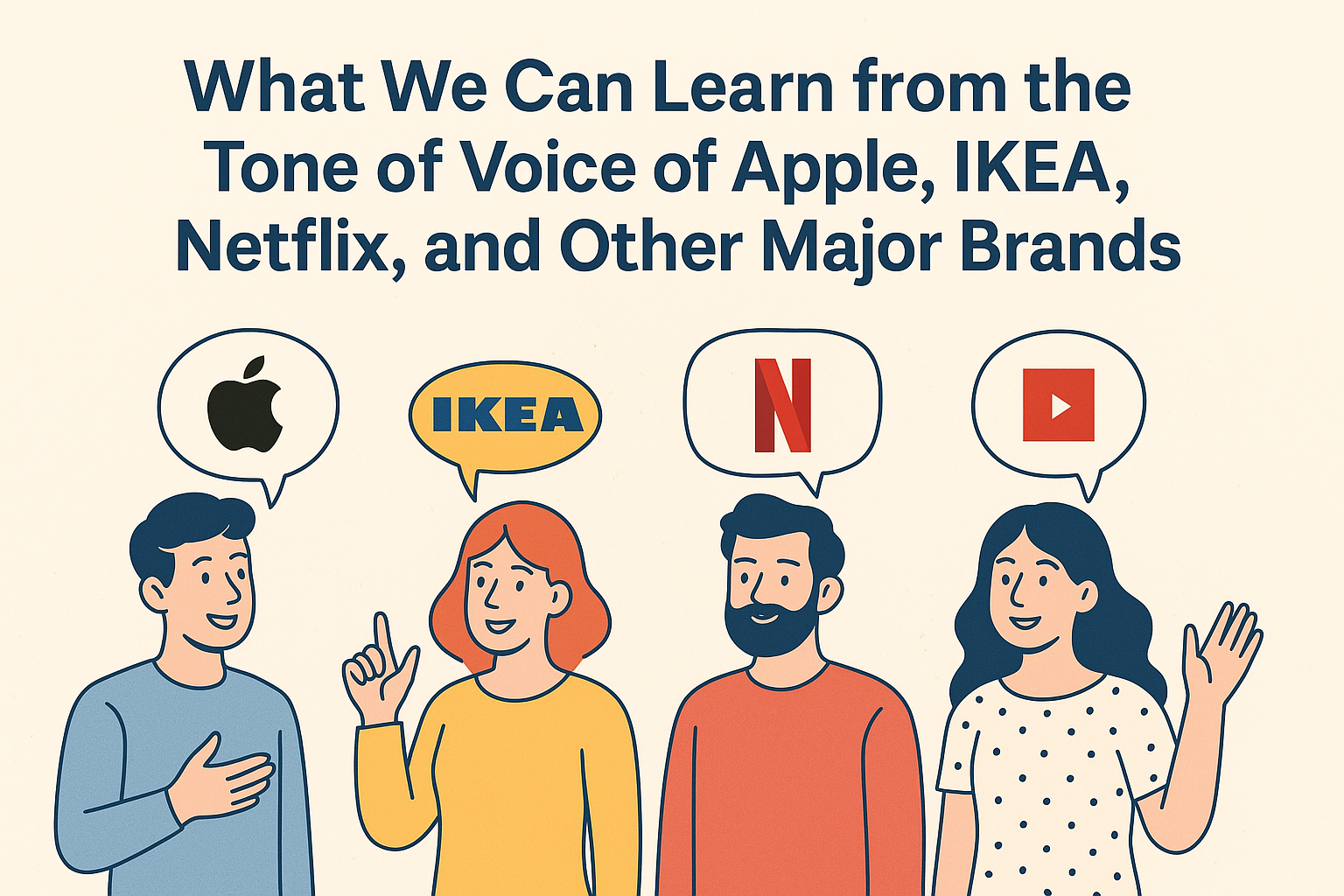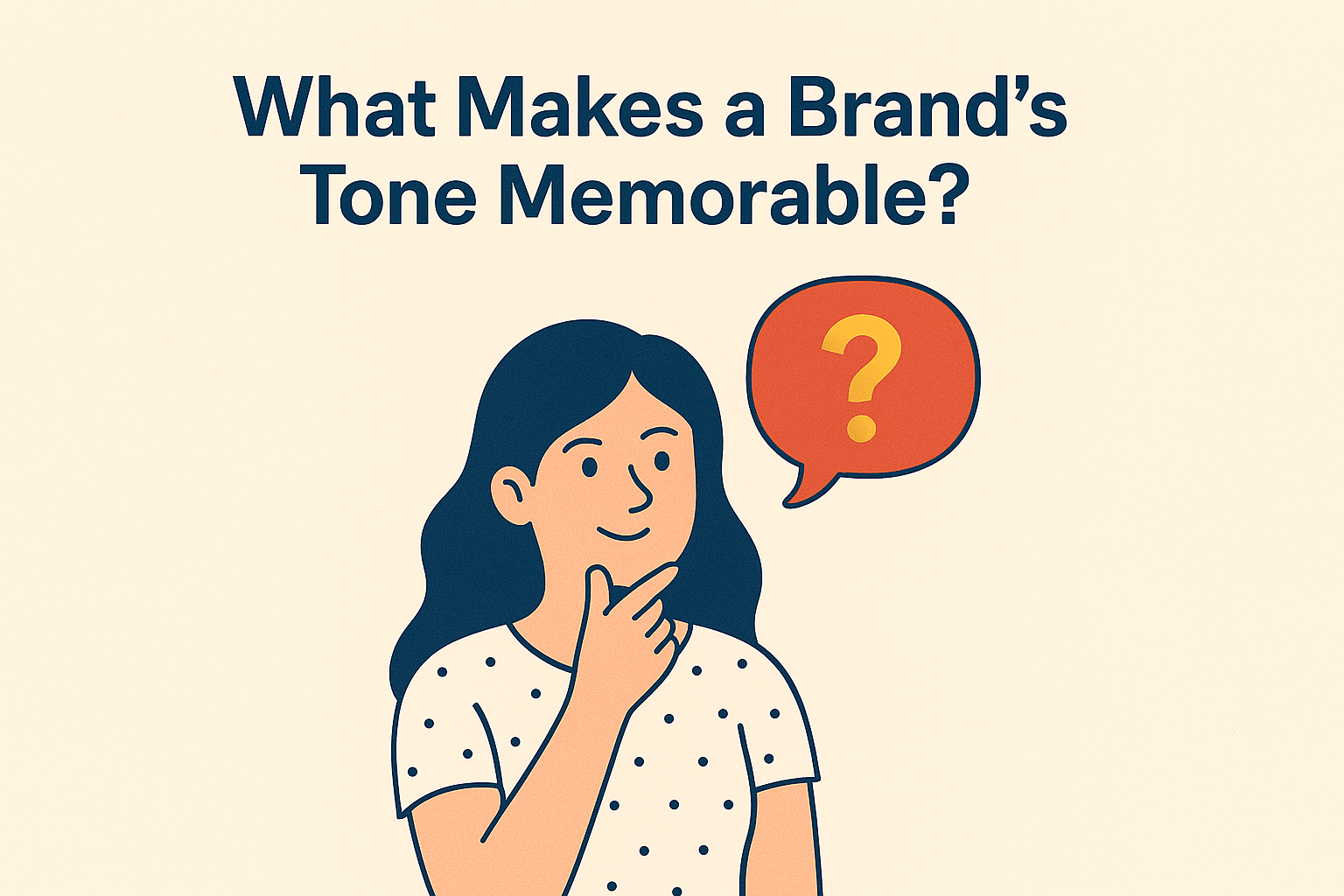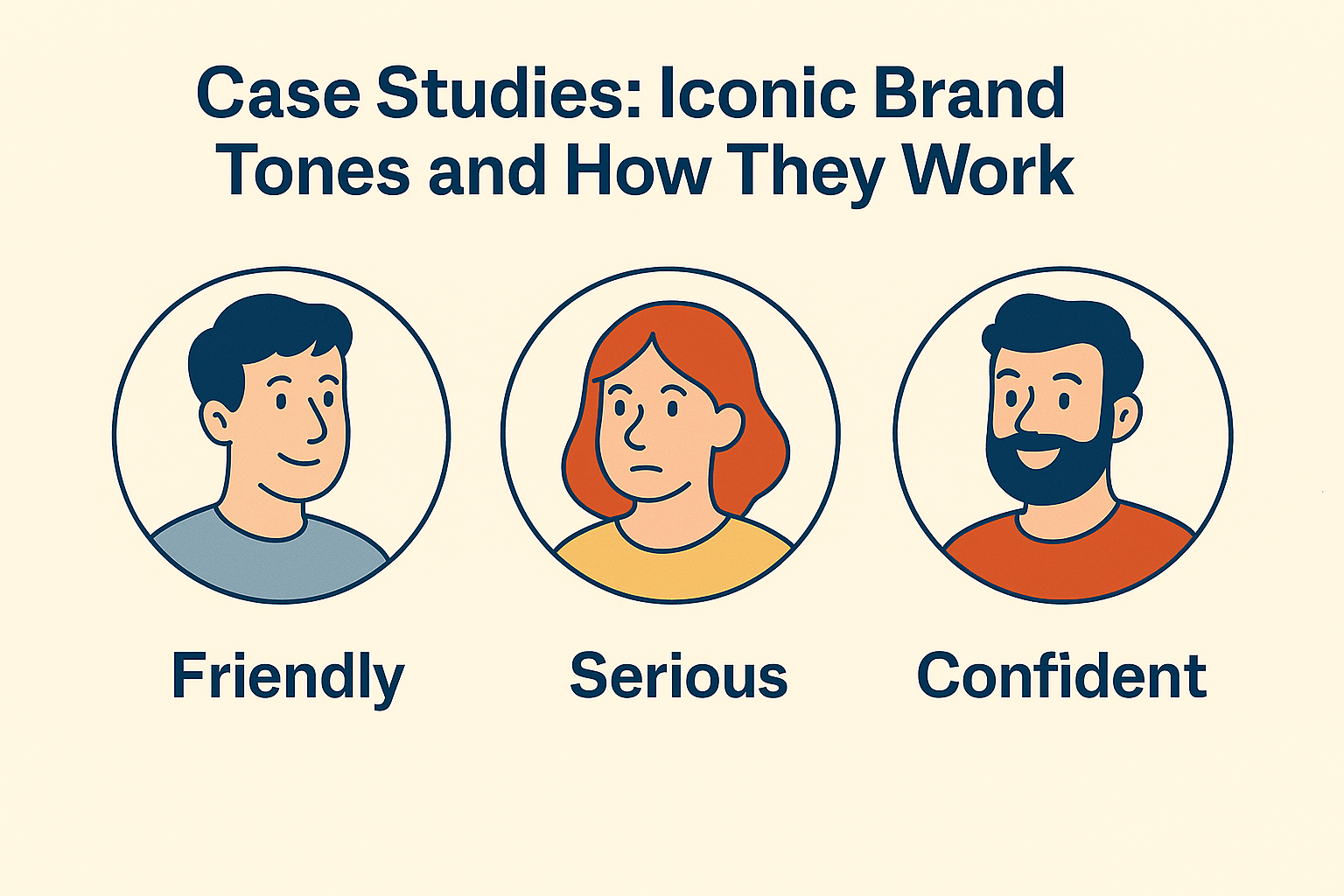What We Can Learn from the Tone of Voice of Apple, IKEA, Netflix, and Other Major Brands

When you read Apple’s website, it feels sleek and self-assured. IKEA’s copy? Friendly, simple, with just a hint of playful charm. Open Netflix on social media and you’re met with casual, witty language that sounds more like a friend than a corporation. These brands aren’t just selling products — they’re communicating with purpose, using tone of voice as a strategic tool to build connection, trust, and identity.
Tone of voice is more than word choice — it’s the personality that breathes through every sentence a brand writes. And for globally recognized companies, it plays a central role in how they differentiate themselves and stay memorable in a crowded market.
In this article, we’ll explore how brands like Apple, IKEA, Netflix, Mailchimp, and Patagonia have crafted distinct and effective tones of voice — and more importantly, what you can learn from their strategies to shape your own. Whether you’re building a new brand or refining an existing one, the way your business “sounds” can become one of your most powerful marketing assets.
What Makes a Brand’s Tone Memorable?

Before diving into real-world examples, it’s important to understand what sets an effective tone of voice apart from forgettable or inconsistent brand communication.
A memorable tone of voice isn’t just clever wording or a trendy writing style — it’s a deliberate and consistent expression of a brand’s identity. Here are the key characteristics that make a brand’s tone stand out:
Consistency Across Touchpoints: From a homepage headline to a customer service email, a strong brand tone is recognizable wherever it appears. This consistency reinforces trust and helps build familiarity over time.
Alignment with Brand Values: The tone should reflect what the brand stands for. A company that champions innovation will likely sound bold and forward-thinking, while one focused on care and community might favor warmth and empathy.
Audience Relevance: Successful brands understand how their audience speaks and tailor their tone to meet them where they are. Mirroring the audience’s communication style creates a sense of resonance and relatability.
Emotional Clarity: The best tones evoke emotion — excitement, trust, curiosity, comfort — without being manipulative. Emotionally aware language strengthens brand affinity and increases engagement.
Tone is what makes copy feel human. It shapes how a message is received and remembered. And when it’s consistent, intentional, and emotionally aligned, it turns everyday communication into a competitive advantage. Let’s see how some of the most iconic brands do exactly that.
Case Studies: Iconic Brand Tones and How They Work

Let’s take a closer look at five global brands that have mastered tone of voice. Each has carved out a distinct identity not just through design or product, but through how they sound across every customer interaction. Their approaches offer valuable lessons for any business looking to strengthen its own communication style.
Apple: Confident, Minimalist, Aspirational
Apple’s tone reflects its design philosophy — clean, elegant, and understated. It avoids unnecessary words and favors short, punchy sentences that let the product speak for itself. Apple doesn’t shout; it simply presents, knowing its audience values clarity and sophistication.
Example:
“Power. It’s in the Air.”
No explanation needed — just bold, confident messaging that assumes intelligence in its reader.
Lesson:
If your brand is positioned as premium or cutting-edge, a minimalist tone with well-placed emphasis can elevate your message. Don’t over-explain. Trust the audience’s perception.
IKEA: Friendly, Down-to-Earth, Helpful
IKEA’s tone is approachable, practical, and slightly humorous — much like its products. Whether it’s a catalog description or a tweet, the brand keeps language simple and welcoming, reflecting its mission to make everyday life better.
Example:
“We love homes. That’s why we spend so much time inside yours.”
Lesson:
Speak like a real person. Especially for mass-market brands, warmth and relatability help build emotional connection and trust.
Netflix: Casual, Bold, Culture-Savvy
Netflix’s tone is relaxed, sometimes cheeky, and always tuned into pop culture. It mirrors the way people talk about shows and movies, using humor, slang, and strong opinions to feel part of the conversation rather than above it.
Example:
“If you’re watching with subtitles, you’re doing it right.”
Lesson:
When your brand lives in the culture it serves, matching the tone of your audience helps you feel authentic, not corporate. This is especially powerful on social media.
Mailchimp: Quirky, Supportive, Human
Mailchimp is a tech company that writes like a friendly creative partner. Its tone blends clarity with playful language and occasional oddball humor — all while maintaining a sense of helpfulness.
Example:
“Audience? Segmented. Campaign? Scheduled. Vibe? Immaculate.”
Lesson:
Even in B2B, personality matters. Don’t be afraid to show character, as long as it supports the user experience and builds trust.
Patagonia: Direct, Activist, Purpose-Driven
Patagonia’s tone is rooted in its values. It doesn’t embellish or over-polish. Instead, it communicates with clarity, urgency, and integrity — especially on environmental issues.
Example:
“We’re in business to save our home planet.”
Lesson:
If your brand is mission-led, let your tone reflect that mission. Honesty, transparency, and conviction can speak louder than marketing polish.
What Small Businesses Can Learn from These Tones
You don’t need to be a global brand to develop a distinct, memorable tone of voice. In fact, a clear tone is one of the most accessible ways for small businesses to stand out. While companies like Apple or Netflix have entire teams dedicated to brand communication, their approaches are grounded in principles any business can apply.
Here’s what you can take away and implement today:
1. Clarity Over Complexity
Big brands like Apple and Patagonia don’t try to impress with complexity — they focus on clarity. For smaller businesses, avoiding jargon and writing plainly can feel more confident and accessible. A simple sentence that says exactly what the customer needs to know builds more trust than overly clever phrasing.
2. Let Your Personality Come Through
Netflix and Mailchimp succeed because their tone sounds human. You can achieve the same by writing like you speak, within reason. Don’t flatten your content into corporate clichés — infuse it with personality that reflects your values and the way your team interacts with customers.
3. Match Your Audience’s Energy
Notice how IKEA talks to everyone, while Apple talks to aspirational buyers. Think about your audience: Are they looking for excitement? Reassurance? Expertise? Mirror their tone to show you understand them. Use customer feedback, reviews, or social media comments to guide how they naturally communicate.
4. Consistency Creates Familiarity
It doesn’t matter how great your tone is if it changes from one channel to another. Whether it's your homepage, social media post, or invoice email — your tone should feel like it's coming from the same “person.” Use templates, examples, and internal documentation to help keep your voice aligned.
5. Start Simple, Then Refine
You don’t need a 30-page brand book to begin. Choose 3–4 adjectives that describe how your brand should sound (e.g. friendly, honest, playful, confident), and write a few examples of what that looks like. Use that as your starting point, and evolve from there as your brand grows.
Tips for Defining Your Own Brand Tone (Inspired by the Greats)
Learning from established brands is one thing — building your own voice is another. The good news? You don’t need a global team or years of content to define a tone that feels right for your business. Here’s how to get started, using practical steps grounded in what works for Apple, Netflix, and others.
1. Choose Your Core Tone Descriptors
Start by identifying 3–4 adjectives that reflect your brand’s personality and how you want to sound. These might include:
- Confident
- Playful
- Helpful
- Sophisticated
- Bold
- Empathetic
Think of this as setting the “mood” of your brand’s voice.
Tip: If you’re unsure, think about how you want your customers to feel after interacting with you. That emotional result often hints at the tone you need to use.
2. Define “Do’s and Don’ts” for Each Descriptor
Words like “friendly” or “witty” mean different things to different people. To avoid confusion (especially if you work with a team), clarify what each tone trait should and shouldn’t look like in practice.
Example (Playful):
- Do: Use light, casual language. Ask fun questions.
- Don’t: Overuse jokes. Avoid sarcasm that could be misunderstood.
- Example (Confident):
- Do: Speak clearly and assertively. Focus on solutions.
- Don’t: Sound arrogant or dismissive.
3. Create a Short Tone of Voice Guide
Document your tone and examples in a simple guide. This doesn’t have to be complex — even a 2-page PDF or Google Doc can make a big difference. Include:
- Your brand’s core tone traits
- “Do and Don’t” examples
- Real copy snippets that reflect the tone
- Notes on tone variation across channels (e.g., website vs. social)
4. Practice and Refine
Start applying your tone to real content — a blog post, a product description, a social media caption. Review how it sounds. Ask others (especially people unfamiliar with your brand) how the message feels. Over time, you’ll refine your tone until it feels second nature.
Conclusion: Use Your Tone as a Strategic Advantage
The way your brand sounds can be just as influential as what it offers. As we’ve seen through examples like Apple’s elegance, IKEA’s warmth, Netflix’s cultural fluency, Mailchimp’s charm, and Patagonia’s purpose-driven honesty — tone of voice isn’t just a creative detail; it’s a brand asset.
You don’t need their budgets to apply the same principles. With a clear tone that reflects your values and resonates with your audience, you can:
- Build stronger emotional connections
- Create consistency across every touchpoint
- Stand out in crowded, competitive markets
- Communicate with clarity and confidence
Defining your tone is just the beginning. Applying it across channels, evolving it as your brand grows, and training your team to use it well — that’s where it becomes truly powerful.
So start small. Pick your adjectives. Test your tone. Refine your message. Over time, your brand voice will not only become recognizable — it will become trusted. And in a marketplace full of noise, that trust is what people remember.





